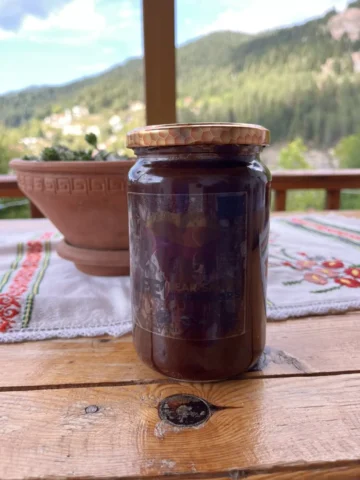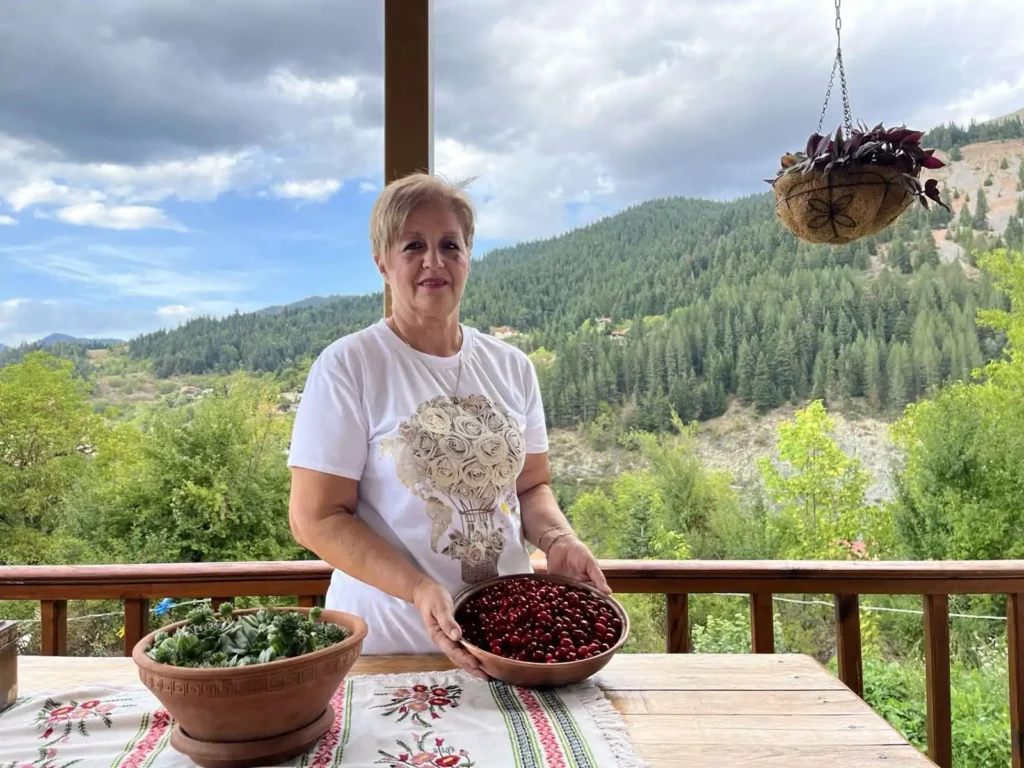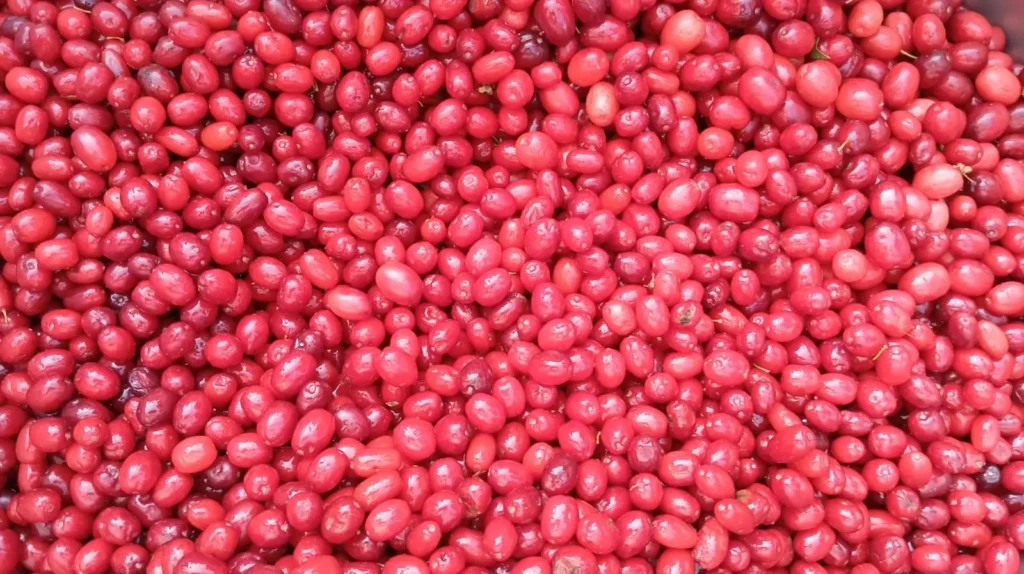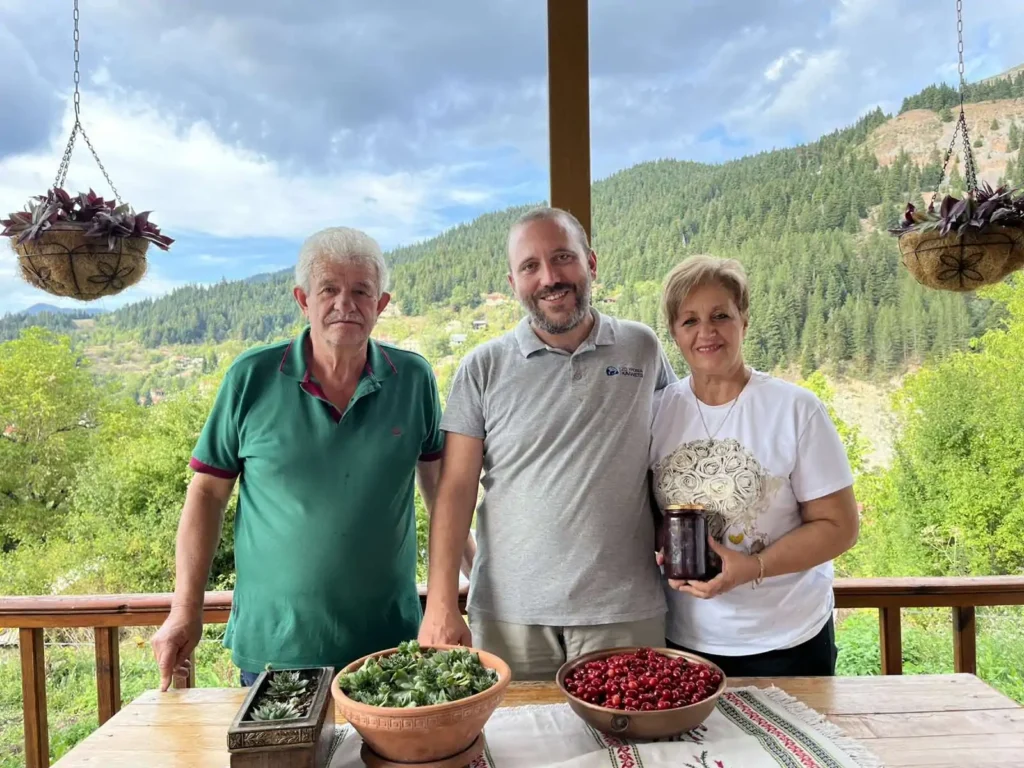A conversation in Kranea (Greece) about place, the brown bear, and the things that keep a village alive.
A village that finds you
Kranea Aspropotamou (La Korno in Vlach) is one of those villages you don’t really search for on a map — it finds you. Something draws you there, a sense that something precious still endures, like a whisper in lands that slowly slipped into silence.
As you climb to 1,150 meters, up the slopes of Mount Triggia in the southern Pindos, the landscape begins to shift. Stone houses scented with woodsmoke, flower-filled courtyards, the murmur of running water. An alpine backdrop unfolds — towering fir trees that hold up the sky, encircled by the Koziaκas peaks standing like guardians of the people and their secrets.
It was here that we were welcomed into the home of Mrs. Kalypsó Palioú and her husband, Mr. Giorgos Paliós. Together they carry memories of another era, along with a tireless determination to keep their village alive — its people, its stories, its flavors, its intangible heritage. Sitting on their balcony overlooking the forest, we spoke about life in the mountains, the knowledge at risk of being lost, the brown bear that increasingly ventures into villages, and the ways a community struggles to reimagine itself today.
The conversation did not feel like an “interview.” It felt more like a shared walk through a hospitable landscape — along paths of the past, into courtyards once brimming with life, to the forest’s edge where people and wild creatures learn to coexist.
For them, Kranea is not just a dot on a map, but a living place with soul and character — changing, but resisting. A place that asks those who love it to constantly remake it, through festivals, stories, flavors, and acts of mutual care.
“If you truly liked it, we’ll know by whether you come back,” says Mrs. Kalypsó with a smile. A bride in Kranea for forty-eight years now, she remembers: “At first, Giorgos and I would just visit. Then we decided to put down roots, to build our home here.” She laughs at her first impression: “That first climb had so many turns, I told him to sell the land. I was dizzy! But it was during a heatwave. Down in Kalambaka, we could barely breathe from the heat; here, we slept under a blanket. That’s when we knew this would be our place.”
Over time, the dirt road turned to asphalt, and the journey grew easier. “For someone coming up the mountain for the first time, the ascent feels endless. But once you see the fir trees and breathe the cool air, it all makes sense.”
Kranea: a village that refused to disappear
Like so many other villages in Greece, Kranea was burned to the ground in October 1943 by the Wehrmacht. Before the war it was one of the largest villages in the southern Pindos: about 650 houses, dairies, “kesaries” for cheese-making, thousands of sheep and cattle, an administrative office, police, courthouse, and school. Children attended classes only in autumn and spring, since in winter the snow could reach two and a half meters, closing the schools for months.
After the war, the village was rebuilt almost from scratch. A few surviving stone houses were restored, new ones constructed, the square renewed, the school reopened. By the mid-1950s and ’60s, Kranea counted only 50 inhabited homes — yet its people refused to let it fade away.
In the 1990s, with the arrival of EU development programs, a new — though often fragmented — wave of tourism appeared. Guesthouses opened, paths were restored, fountains and single-arched stone bridges were showcased as visitor attractions. But the boom was often hasty and detached from local needs. Some of the large hotels built then stand closed or half-ruined today, ghosts of a passing euphoria rather than symbols of sustainable planning. Storm Daniel, which recently destroyed key infrastructure in the area, only deepened the fragility of this mountain landscape, leaving an open question: what kind of future can this place truly sustain?
Everyday wisdom and the threads of memory
Mrs. Kalypsó recalls the old pastoral world with a hint of longing: “Once, thousands of animals grazed here. Families kept big herds. Now, there’s almost nothing left.” Indeed, since the 1960s, urbanization and the shift in production models eroded traditional transhumant herding until it nearly vanished — though its flavors, habits, and memories still shape Aspropotamos’ identity.
According to the 2021 census, Kranea has 62 permanent residents and empties in winter, like most villages of the region. Yet in summer, it comes alive again, hosting up to 2,500–3,000 people — locals and visitors alike. “The neighborhood feasts return,” says Mrs. Kalypsó. “Ten, fifteen people around a table, everyone bringing food to share.”
The village still safeguards its cultural heritage: the historic Monastery of the Holy Cross, the old Sarakatsani lodgings, its two stone bridges, traditional fountains. At the entrance, the “Old Watermill” now hosts exhibitions, a reading and lending library, and a children’s playroom.
The Cultural Association of Kranea, one of the oldest in Aspropotamos (founded in 1948), organizes countless activities — from dance classes and cooking workshops to hiking trips and the annual Cornelian Cherry Festival each September, which this year also welcomed Callisto and members of the Bear-Smart Community. Every August 1, the village revives the old “Protavgoustia” feast — beans from the cauldron, lenten dishes, music, all free for visitors.
In the square, the community guesthouse fills the air with the smell of coffee and warm meals, while the tavern still serves bean soup, trachana soup, and local cheeses. Higher up, the “Gorgkatsi” terrace — the balcony of Kranea — buzzes with clinking glasses and home-cooked meze, a meeting point for returnees and first-time visitors alike. And just beyond, the old LaKorno grill house, weathered but stubborn, still stands at the bend of the “main” road of Aspropotamos — a reminder that hospitality here has never been mere business, but part of the village’s soul.
Bears, storms, and coexistence
In Kranea’s square stands a statue of the brown bear — the village’s emblem. Yet, as Mrs. Kalypsó explains, “In recent years, bears come right down to the houses. Wild animals should live in their space. If they find food in our garbage, they’ll return. We mustn’t leave food outside. Today it’s a cub; tomorrow, a grown bear. Fear brings accidents. People in mountain villages need information. This is bear country, but we too must know how to behave.”
Waste management is a constant struggle. “In summer, with so many visitors, the bins overflow and turn into buffets for bears. The garbage truck passes only twice a week in summer, once a week in September.” Solutions may be simple — but they require coordination between municipalities and residents, who must treat waste management not as routine but as a condition for health, safety, and coexistence.
The village also faces scars from extreme weather. Storms Ianos and Daniel devastated the Aspropotamos valleys: landslides, broken roads, bleeding springs. “When we came after the storm, we didn’t recognize the mountain curves,” says Mrs. Kalypsó. “The wounds are still open. If the roads aren’t fixed, the villages will empty.”
Her husband Giorgos adds: “After the storms, no one knows where the water flows anymore. There’s a constant roar in the mountain. Rural areas need support, or Greece will be left with only big cities.”
The taste of a place
Mrs. Kalypsó speaks of food as if unlocking cupboards filled with memory:
- Cornelian cherry liqueur: “Ripe fruit, cognac, and sugar in equal parts. Leave in the sun till December. The secret is that it must smell of fruit.”
- Cornelian cherry jam: Balanced with a couple of sweet apples to soften the tartness.
- Aspropotamos trout: Pan-fried in fresh butter with cornmeal — “that’s when its flavor soars.”
- Vlach pies: Nettle, spinach, milk, trachanas — always with butter, never oil.
- Kousiafia: Dried fruits, kept in woolen bags for winter compotes.
- Traditional sweets: Baklava, melahrini, kourabiedes — all butter-based, warming the winter like the old wood stoves.
Each recipe, she says, is not just food but a fragment of history.
Looking ahead
 Toward the end, Mrs. Kalypsó falls quiet, gazing at the forest. Her voice softens: “We must all try together — community, municipality, state, simple people and summer visitors — to leave something better for our children and grandchildren. To rebuild our communities from the ground up. So our village doesn’t survive only in photographs.”
Toward the end, Mrs. Kalypsó falls quiet, gazing at the forest. Her voice softens: “We must all try together — community, municipality, state, simple people and summer visitors — to leave something better for our children and grandchildren. To rebuild our communities from the ground up. So our village doesn’t survive only in photographs.”
She remembers the old festivals, the cooperatives that vanished, the wooden kiosks that rotted away, the flocks that never came up this summer. “I don’t want to see those things disappear. I want our children to love this land, to want to return — not only for holidays, but to live, to care, to build.”
As we step back into the yard, September already carries the scent of autumn. Among the dark green firs, strokes of yellow and orange begin to spread.
“A painting,” says Mrs. Kalypsó. And we agree: as long as there are people who care for their land, for wildlife, and for one another, there is still a path toward coexistence. And a reason to return.
The interview was conducted by Dr. Giorgos Chatzinakos in September 2025 in Kranea, within the framework of the LIFE Bear-Smart Corridors project and the activities of the Bear-Smart Community coordinated by the environmental NGO Callisto.
Our heartfelt thanks to Mrs. Kalypsó Palioú and Mr. Giorgos Paliós, who opened not only their home but their world to us. In their words we found the thread that binds memory, place, and people. We also thank the residents of Kranea, who welcomed us as if we were old friends, allowing us to feel — even for a moment — part of a place that insists on living, and on resisting the passing of time.



